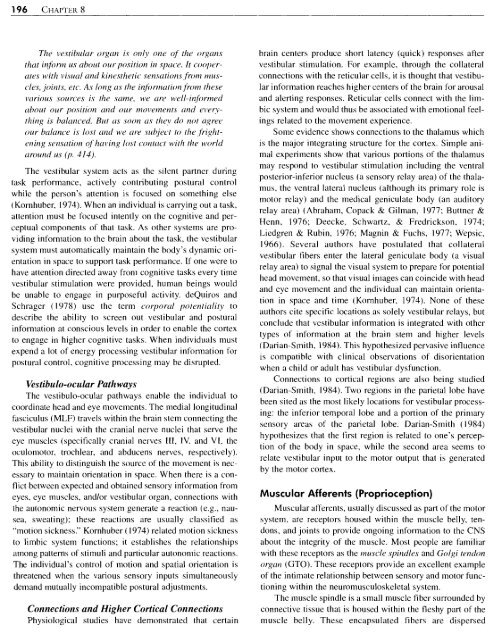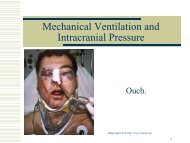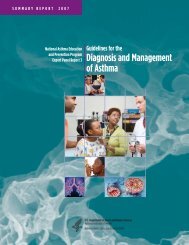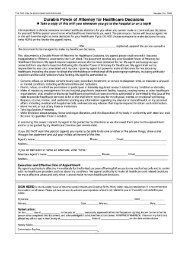Implementing Neuroscience Principles to Support Habilitation and ...
Implementing Neuroscience Principles to Support Habilitation and ...
Implementing Neuroscience Principles to Support Habilitation and ...
Create successful ePaper yourself
Turn your PDF publications into a flip-book with our unique Google optimized e-Paper software.
The vestrhrdar organ is only one of the organs<br />
that infiwm us ahorrt our- position in spuce. It cooperates<br />
with visual und kinesthetic sen.\utions frorn rnuscles,<br />
joints, etc. As long as the infi)rinution from these<br />
vrrrious sources is the .same, we are well-infbrmed<br />
about our position <strong>and</strong> our movernent.v cuzd el3ery<br />
thing is balanced. &it as soon as thev do not agrer<br />
our hnlance is lost <strong>and</strong> we are .sub/e~.<strong>to</strong> the frightening<br />
s~ns~~tion oj'hal~ing lost contc~ct with the world<br />
urourzd us (17. 114).<br />
The vestibular system acts as the silent partner during<br />
task performance, actively contributing postural control<br />
while the person's attention is focused on something else<br />
(Kornhuber, 1974). When an individual is carrying out a task,<br />
attention must be focused intently on the cognitive <strong>and</strong> perceptual<br />
components of that task. As other systems are providing<br />
information <strong>to</strong> the brain about the task, the vestibular<br />
system must au<strong>to</strong>matically maintain the body's dynamic orientation<br />
in space <strong>to</strong> support task performance. If one were <strong>to</strong><br />
have attention directed away from cognitive tasks every time<br />
vestibular stimulation were provided. human beings would<br />
be unable <strong>to</strong> engage in purposeful activity. deQuiros <strong>and</strong><br />
Schrager (1978) use the term corporal potentitrlity <strong>to</strong><br />
describe the ability <strong>to</strong> screen out vestibular <strong>and</strong> postural<br />
information at conscious levels in order <strong>to</strong> enable the cortex<br />
<strong>to</strong> engage in higher cognitive tasks. When individu, ‘1 1 s must<br />
expend a lot of energy processing vestibular information for<br />
postural control, cognitive processing may be disrupted.<br />
Vestibulo-ocular Pathways<br />
The vestibulo-ocular pathways enable the individual <strong>to</strong><br />
coordinate head <strong>and</strong> eye movements. The medial longitudinal<br />
fasciculus (MLF) travels within the brain stem connecting the<br />
vestibular nuclei with the cranial nerve nuclei that serve the<br />
eye muscles (specifically cranial nerves 111, IV. <strong>and</strong> VI. the<br />
oculomo<strong>to</strong>r, trochlear, <strong>and</strong> abducens nerves, respectively).<br />
This ability <strong>to</strong> distinguish the source of the movement is necessary<br />
<strong>to</strong> maintain orientation in space. When there is a conflict<br />
between expected <strong>and</strong> obtained sensory information from<br />
eyes. eye muscles, <strong>and</strong>/or vestibular organ, connections with<br />
the au<strong>to</strong>nomic nervous system generate a reaction (e.g., nausea,<br />
sweating): these reactions are usually classified as<br />
"motion sickness." Kornhuber ( I 974) related motion sickness<br />
<strong>to</strong> limbic system functions; it establishes the relationships<br />
among patterns of stimuli <strong>and</strong> particular au<strong>to</strong>non~ic reactions.<br />
The individual's control of motion <strong>and</strong> spatial orientation is<br />
threatened when the various sensory inputs simultaneously<br />
dem<strong>and</strong> mutually incompatible postural adjustments.<br />
Connections <strong>and</strong> Higher Cortical Connections<br />
Physiological studies have demonstrated that certain<br />
brain centers produce short latency (quick) responses after<br />
vestibular stimulation. For example, through the collaterd<br />
connections with the reticular cells, it is thought that vestibular<br />
information reaches higher centers of the brain for arousal<br />
<strong>and</strong> alerting responses. Reticular cells connect with the limbic<br />
system <strong>and</strong> would thus be associated with emotional feelings<br />
related <strong>to</strong> the movement experience.<br />
Some evidence shows connections <strong>to</strong> the thalamus which<br />
is the major integrating structure for the cortex. Simple animal<br />
experiments show that various portions of the thalamus<br />
may respond <strong>to</strong> vestibular stimulation including the ventral<br />
posterior-inferior nucleus (a sensory relay area) of the thalamus,<br />
the ventral lateral nucleus (although its primary role is<br />
mo<strong>to</strong>r relay) <strong>and</strong> the medical geniculate body (an audi<strong>to</strong>ry<br />
relay area) (Abraham, Copack & Gilman, 1977; Buttner &<br />
Henn, 1976; Deecke, Schwartz, & Fredrickson, 1974;<br />
Liedgren & Rubin, 1976; Magnin & Fuchs, 1977; Wepsic,<br />
1966). Several authors have postulated that collateral<br />
vestibular fibers enter the lateral geniculate body (a visual<br />
relay area) <strong>to</strong> signal the visual system <strong>to</strong> prepare for potential<br />
head movement, so that visual images can coincide with head<br />
<strong>and</strong> eye movement <strong>and</strong> the individual can maintain orientation<br />
in space <strong>and</strong> time (Kornhuber, 1974). None of these<br />
authors cite specific locations as solely vestibular relays, but<br />
conclude that vestibular information is integrated with other<br />
types of information at the brain stem <strong>and</strong> higher levels<br />
(Darian-Smith, 1984). This hypothesized pervasive influence<br />
is compatible with clinical observations of disorientation<br />
when a child or adult has vestibular dysfunction.<br />
Connections <strong>to</strong> cortical regions are also being studied<br />
(Darian-Smith, 1984). Two regions in the parietal lobe have<br />
been sited as the most likely locations for vestibular processing:<br />
the inferior temporal lobe <strong>and</strong> a portion of the primary<br />
sensory areas of the parietal lobe. Darian-Smith (1984)<br />
hypothesizes that the first region is related <strong>to</strong> one's perception<br />
of the body in space, while the second area seems <strong>to</strong><br />
relate vestibular input <strong>to</strong> the mo<strong>to</strong>r output that is generated<br />
by the molor cortex.<br />
Muscular Afferents (Proprioception)<br />
Muscular afferents, usually discussed as part of the mo<strong>to</strong>r<br />
system. are recep<strong>to</strong>rs housed within the muscle belly, tendons,<br />
<strong>and</strong> joints <strong>to</strong> provide ongoing information <strong>to</strong> the CNS<br />
about the integrity of the muscle. Most people are familiar<br />
with these recep<strong>to</strong>rs as the rnliscle spiwdles <strong>and</strong> Golgi tendon<br />
organ (GTO). These recep<strong>to</strong>rs provide an excellent example<br />
of the intimate relationship between sensory <strong>and</strong> mo<strong>to</strong>r functioning<br />
within the neuromusculoskeletal system.<br />
The muscle spindle is a small muscle fiber surrounded by<br />
connective tissue that is housed within the fleshy part of the<br />
muscle belly. These encapsulated fibers are dispersed





